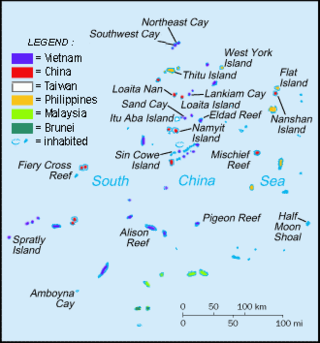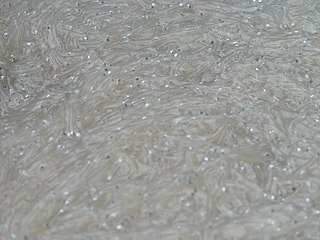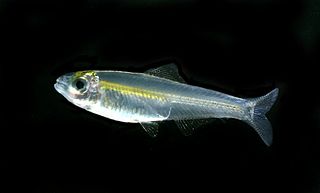
The Spratly Islands are a disputed archipelago in the South China Sea. Composed of islands, islets, cays, and more than 100 reefs, sometimes grouped in submerged old atolls, the archipelago lies off the coasts of the Philippines, Malaysia, and southern Vietnam. Named after the 19th-century British whaling captain Richard Spratly who sighted Spratly Island in 1843, the islands contain less than 2 km2 of naturally occurring land area, which is spread over an area of more than 425,000 km2 (164,000 sq mi).

Cod is the common name for the demersal fish genus Gadus, belonging to the family Gadidae. Cod is also used as part of the common name for a number of other fish species, and one species that belongs to genus Gadus is commonly not called cod.

Herring are forage fish, mostly belonging to the family of Clupeidae.

Sprat is the common name applied to a group of forage fish belonging to the genus Sprattus in the family Clupeidae. The term also is applied to a number of other small sprat-like forage fish. Like most forage fishes, sprats are highly active, small, oily fish. They travel in large schools with other fish and swim continuously throughout the day.

The European sprat, also known as bristling, brisling, garvie, garvock, Russian sardine, russlet, skipper or whitebait, is a species of small marine fish in the herring family Clupeidae. Found in European waters, it has silver grey scales and white-grey flesh. Specific seas in which the species occurs include the Irish Sea, Black Sea, Baltic Sea and Sea of the Hebrides. The fish is the subject of fisheries, particularly in Scandinavia, and is made into fish meal, as well as being used for human consumption. When used for food it can be canned, salted, breaded, fried, boiled, grilled, baked, deep fried, marinated, broiled, and smoked.

The Australian sprat is a sprat fish whose habitat ranges in the waters surrounding Australia including Tasmania. It is a pelagic fish which is found in anti-tropical, temperate water. It is apart of the Clupeidae family. Other members of the Cluepeidae family also include herring, menhaden, sardines as well as shads. It is currently a relative unknown species of Sprat compared to the other members of the family. In total, there are five different types of True Sprats. What makes Australian Sprats different from the rest is their location and appearance. Sprattus Novaehollandiae have a dark blue back and a protruding lower jaw. They are found in the Southern regions of Australian such as lower Victoria and Tasmania were there are colder climates. On average, Australian Sprat grown up to 14cm and live in the range of 0-50 meters deep in the ocean. They will lay between 10,000 to 40,000 eggs per year and live for approximately 5-7 years. Other names for the Australian Sprat include Clupea Bassensis and Meletta Novaehollandiae.

The rainbow sardine, also known as common sprat, dwarf round herring, rainbow herring, and sharpnosed sprat, is a bony fish important to aquaculture and commercial fisheries.

The New Zealand blueback sprat is a herring-like, forage fish of the family Clupeidae found in the waters around New Zealand, between latitudes 37° S and 48° S, and longitude 166° E and 180° E, to depths of up to 50 m. It belongs to the genus Sprattus, a small oily fish usually known by their common name, sprats. Its length is up to 12 cm.

Sprattus is a genus of small oily fish of the family Clupeidae. They are more usually known by their common name, sprats. There are five species in the genus.
The New Zealand sprat is a herring-like, marine fish in the family Clupeidae found in the subtropical southwest Pacific Ocean endemic to New Zealand. It belongs to a genus Sprattus of small oily fish, usually known by their common name, sprats.

Namyit Island, also known as Vietnamese: Đảo Nam Yết; Binago Island ; Mandarin Chinese: 鴻庥島/鸿庥岛; pinyin: Hóngxiū Dǎo, is the third-largest island on Tizard Bank in the northwest of the Spratly Islands in South China Sea. With an area of 5.3 hectares, it is the twelfth-largest naturally-occurring Spratly island, and the fifth-largest among the Vietnamese-administered islands. The island is also claimed by China (PRC), the Philippines, and Taiwan (ROC).

Hyperlophus is a genus of sprat belonging to the herring family Clupeidae. They are endemic to the waters around Australia. There are currently two species recognized in the genus.

Clupeoides is a genus of sprats that occur in rivers in Southeast Asia. There are currently four recognized species in the genus.
Abrau sprat, Clupeonella abrau, is a species of freshwater fish in the family Clupeidae. It is found landlocked in Russia in a single locality, Lake Abrau, located at 70 m above sea level near the Black Sea coast close to Novorossiysk. The lake is small and has been stocked by several alien species, whence the Abrau sprat is considered critically endangered.

Whitebait is a collective term for the immature fry of fish, typically between 25 and 50 millimetres long. Such young fish often travel together in schools along coasts, and move into estuaries and sometimes up rivers where they can be easily caught using fine-meshed fishing nets. Whitebaiting is the activity of catching whitebait.
The M74 syndrome is a reproduction disorder of salmon feeding in the Baltic Sea. M74 manifests as offspring mortality during the yolk-sac fry phase. Before dying, the yolk-sac fry display typical symptoms. Thiamine deficiency in eggs is the immediate cause of M74 mortality. The deficiency can be prevented by thiamine treatments. For the first time Bulgarian research team opines that with M74 syndrome are affected also male gametes and worsened parameters of the spermiogram. The use of Bulgarian semen protective media 49282, 49283 and 49397 for trout sperm fertility improving was proposed.

Clupeichthys is a genus of sprats, herring-like fishes, that occur in rivers in Southeast Asia. There are currently four recognized species in the genus.

Corica is a small genus of sprats that occur in rivers in South Asia and Southeast Asia. Two described species are placed in the genus.

Microthrissa is a genus of sprats in the herring family, Dorosomatidae, which is endemic to Africa. There are five recognized species in the genus.
Platanichthys platana, the Rio Plata sprat, is a very small species of fish belonging to the family, Dorosomatidae. It is endemic to South America. It is the only species in its genus.















